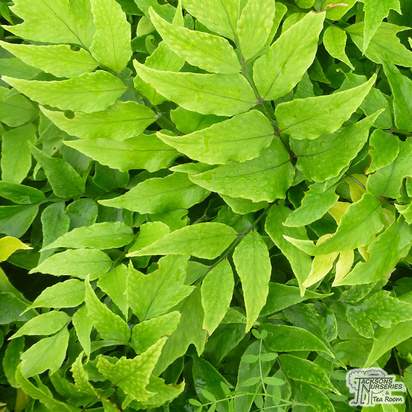Cyrtomium fortunei is commonly referred to as Fortunes cyrtomium getting its name from plant hunter Robert Fortune. A hardy semi-evergreen fern with and upright habit sporting bright green, broad, leathery fronds and distinctive black stems, sometimes called Holly Fern because of the distinctive shape of its fronds. An attractive addition among other ferns and ideal for a shady border amongst other woodland plants. Need humus-rich soil to thrive.
Buying Ferns from Jacksons Nurseries
Please note that at this time of the year, our plants might be dispatched in 9cm pots or freshly potted to ensure timely despatch
Unlike many garden centres, supermarkets and some nurseries here at Jacksons Nurseries we sell the majority of our stock all year round. Our stock is for the most part grown outdoors making it far hardier than those grown under glass and/or only sold ‘In Season’.
Here at Jacksons Nurseries we would favour a hardy outdoor grown plant every time. They are far less likely to suffer from the shock of being planted in colder conditions and they will begin to establish more rapidly the following spring. This can mean that they don’t look like a ‘picture perfect’ plant when purchased out of season but with the correct care and a little time you’ll have a wonderful plant to enjoy for many years to come.
Availability: Stock availability figures are provided as a guide only. There is a delay between orders being placed and the plants being gathered by our pulling team. During this time it may be possible for a member of the public to purchase these plants from our Garden Centre, while this is rare it is a possibility and we will notify you of any problems as soon as possible. This figure may also include plants that have not yet be flagged as unsaleable.
Pre-order: Pre-order times are given as a guide only and may vary dependent on the growing season. Orders containing Pre-ordered products will be shipped as a single order when all items become available. Large orders may be part shipped, please contact us on 01782 502741 or email sales@jacksonsnurseries.co.uk.
Ferns love a sheltered, humid and shady position in the garden and make striking features with a Jurassic, exotic touch. They are slow growing plants with delicate spreading fronds, and they work beautifully as a dramatic focal point in any shady area.
Planting and Conditions
Generally, tougher varieties of fern will tolerate any soil—but they would prefer a free draining soil. Ferns have fine roots, and would prefer loose soil if possible.
Waterlogged soil does not work well for ferns (unless they are wetland or bog garden ferns).
To prepare soil for planting, add compost such as leaf mould, shredded bark or grit and gravel for heavier soil types. Don’t add fresh manure, and be careful with strong fertilizers as the fine roots are very sensitive to it.
Do not plant or move ferns during the winter or dormant season. The best time for planting ferns is between April and October.
Aftercare and Pruning
Ferns, as a rule, do not need any pruning, and are renowned for being very low maintenance. Some ferns need no care at all after the first few years where they must be watered once or twice a week.
Other varieties, and tree ferns in particular, need regular watering during dry spells as the crown and trunk will not tolerate drying out at all. With tree ferns, ensure the trunk remains damp and spray it with water during hot weather, and during dry conditions in the winter months.
To encourage rooting with tree ferns, don’t feed the plant during its first year.
If you are a keen gardener and wish to tend to your ferns more intensively, simply remove any dead fronds when they appear, and apply a small layer of mulch every now and again.
Potential Issues
Woodlice, although not harmful to the plant, can look unsightly and can occasionally damage softer plant tissues. Leave them be, or brush them off if they are causing a problem.
The red spider mite can cause issues, especially if your ferns are kept in greenhouses. They suck sap from leaves, causing unhealthy looking fronds on ferns. Heavily infested plants may die.
If you have a red spider mite infestation in your greenhouse, you can introduce the predatory mite to resolve the problem.
If you would prefer to use chemical controls, do so with pesticides. Avoid spraying them onto nearby flowering plants to avoid harming pollinators.
No posts found


.jpg)

.jpg)